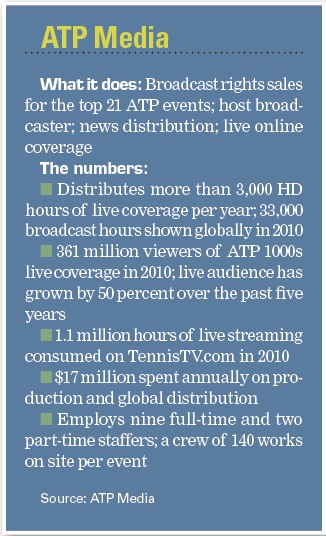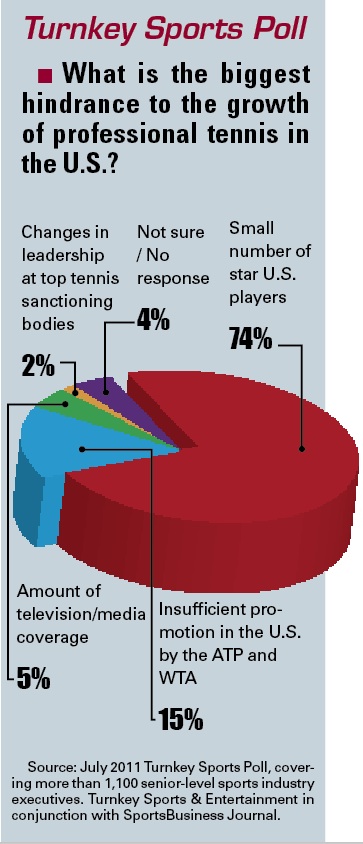What’s the best-kept secret in men’s tennis? On the business side at least, hands down, it’s ATP Media.
While selling media rights collectively is a no-brainer in U.S. sports, whether it’s the NFL or PGA Tour, few if any sports have the challenge of the ATP, which pools rights for its top 21 events, which stretch across the globe from Shanghai to Miami. And if that isn’t enough, the ATP also produces the events’ high-cost feeds, essentially acting as host broadcaster to the world.
 |
BOB PAYNE
This year, ATP Media will produce more than 3,000 hours of live HD programming. |
“There is not a comparable entity that does what they do for their sport,” said Jason Bernstein, ESPN’s senior director of programming and acquisitions. “They represent their rights globally and understand the markets throughout the world. And then they help make it an efficient production, pivoting between the tournament, the ATP and then the broadcasters. It is one-stop shopping.”
ATP Media is structured as a for-profit company headquartered in London, with the top nine tournaments as shareholders and the ATP Tour leader as chairman. This year the company, which produces and distributes the programming, is expected to reap $60 million in revenue from rights fees and online purchases of streamed matches, a figure that has grown 500 percent in the last five years.
Since its inception in 2001, ATP Media has invested $100 million in production and staff. This year the events will invest $17 million alone and produce more than 3,000 hours of live HD, making the entity the largest HD producer of a single sport.
“This has allowed us to have a digital strategy; we can now talk about 3-D,” said Steve Plasto, who joined ATP Media in 2004 and is now CEO. “The tournaments are controlling the investment and delivering what the broadcasters need.”
The concept of ATP Media grew out of the ashes of the failed sports marketing alliance with ISL Worldwide, which overpaid for sports rights, including the ATP’s, and went under a decade ago.
The ATP continued the strategy of pooling media employed by ISL. While it took years to recover from the ISL debacle, the approach is now bearing fruit. Rights fees are up 200 percent in the last five years, Plasto said, and the amount of money flowing back to the events in that time period has surged 400 percent.
The tour could have simply taken a straight fee from a third party, such as IMG or another agency, and allowed them
to sell the rights. Or the rights could have been returned to the tournaments.
But Plasto said ATP Media allows the sport to control the quality of the broadcasts, and to be nimble in reshuffling contracts in countries where the sport might be peaking, or dipping. Right now for example, the sport is hot in eastern Europe, which is generating 10 times the revenue it was just a few years ago, Plasto said.
The top nine events, known as the ATP 1000s, hand over international and domestic TV rights to ATP Media. In the U.S., that is the Miami, Indian Wells, Calif., and Cincinnati events. The next layer of 11 events, which are known as the ATP 500s, control their own domestic rights. Their international sales, however, are controlled by ATP Media, which also sells the season-ending championships.
Elusive WTA joint sales goal
The holy grail for ATP Media is an alliance with the WTA Tour, which earlier this summer rebuffed ATP efforts to merge the two tours’ media rights.
“During our discussions it became very clear our cycles are out of sync,” said Stacey Allaster, the WTA’s chief executive officer. “Their rights are not available until 2014 and ours are in 2013. The first time we could combine them is in 2017. Our members have asked me to tender our rights in 2013 to 2016, with no future provisions, so we
can achieve a strategic goal of combining rights with the men.”
Allaster did not rule out the possibility that, should the WTA’s current tender effort not succeed, the deadline could be accelerated.
 |
BOB PAYNE
ATP Media produces the sport's feeds, which allows the unit to control the quality of broadcasts. |
In the U.S., the separate ATP and WTA sales effort has little effect to the viewer because for those events where men and women play simultaneously, like Miami, the tours have selected the same broadcast entities: Tennis Channel, ESPN and CBS. But overseas, for example, the Miami event in many cases has a separate broadcaster for the women’s matches, and one for the men’s matches.
“It is an inconsistent journey watching the Sony Ericsson,” Allaster said of Miami’s Sony Ericsson Open.
That makes it difficult for the sport to promote its top events effectively when viewers are racing around channels and the quality of the broadcasts differ.
ESPN’s Bernstein believes the WTA would benefit from an alliance with the ATP because now each of the women’s events essentially has its own host broadcaster, meaning the consistency and quality of the feed is different.
And ESPN’s streaming service, ESPN3, benefits from the high quality of the ATP feed, he explained, whereas, again, the quality for WTA matches depends on the host broadcaster.
What’s next?
With ATP Media now the biggest revenue source within men’s tennis, could it be used to cure the imbalance that exists between the top two levels of tournaments, and the third, called the ATP 250s? Many of these 41 events are plagued by
tour rules, employed several years ago, restricting their access to top players.
Some of these events recently asked Plasto, he said, about becoming part of ATP Media.
“There are no plans for the centralisation of 250s, but I have had a number of approaches from individual 250 tournaments to pool media rights,” he wrote in an email. “It is something that does interest me and could make sense for the tour.”
And could the success of ATP Media finance a 3-D push? Maybe.
Tennis on TV has long been challenging, with viewers often having a tough time following the ball and appreciating the athleticism and skill of the players. 3-D could help solve the problem, but for now, Plasto is unsure.
“Dust is still settling on 3-D,” he said. He agreed with many of the concerns raised against 3-D in this country: the need to wear glasses while watching the TV; the sometimes discomforting effect of those glasses; and whether HD needed more time to penetrate the market before 3-D is ready.
But he didn’t dismiss it outright.
“Any technology that can help show the skills of the likes of [Roger] Federer or [Rafael] Nadal has got to be good for tennis,” he said. “The on-site viewing experience is fantastic. Trying to capture that is the challenge.
“3-D turns a television experience into a stadium experience. That is where it can improve tennis.”







